The Role of Link Intent in Link Building and SEO: How It Impacts Search Engine Rankings
Link-building is an integral part of SEO, and it plays a pivotal role in determining your website’s authority and online visibility.
If you’re struggling to generate traffic to your site, it’s likely you’re ignoring the impact of a comprehensive link-building strategy on your site’s ranking. To get started, connect with our professional link-building experts or go through this introductory video.
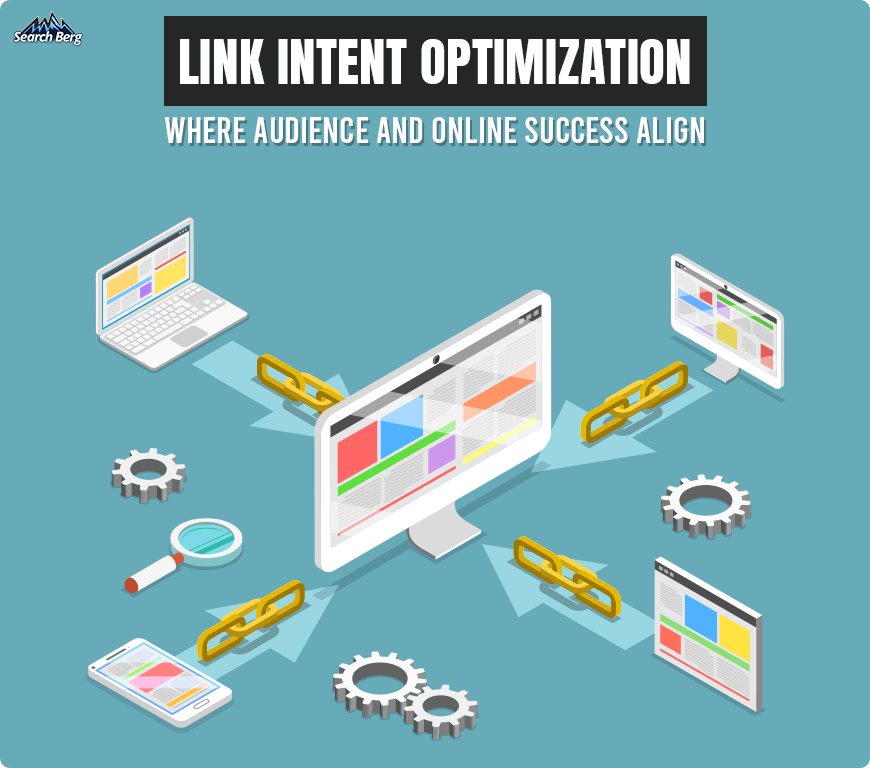
Understanding Link Intent – Creating Purposeful Connections for SEO Success
Have you come across instances where content is linked to other pages on the internet? For example, a medical website offering information about one medical condition might link to its own webpages on related topics.
The screenshot below shows how WebMD connects its blog about bloating to another one about abdominal pain. This is an internal link, meaning it links to web pages that are on the same domain.
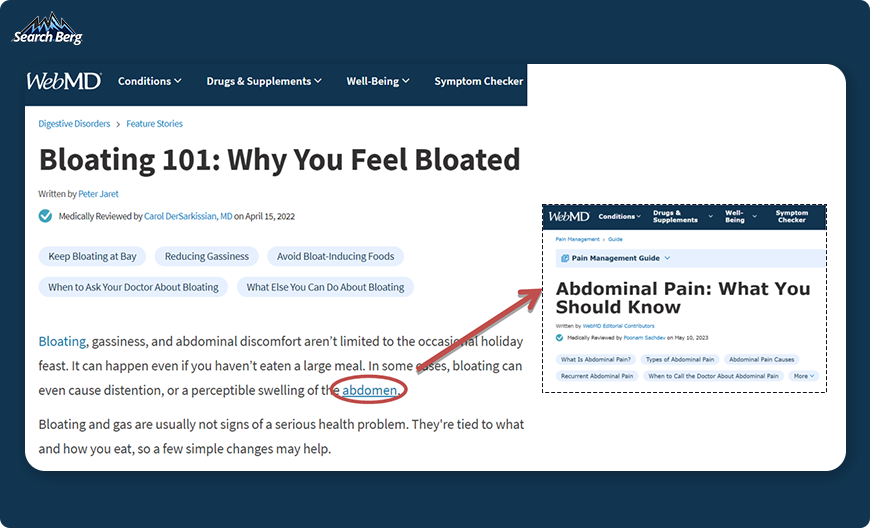
Well-placed internal links have a purpose.
- They improve website navigation by helping users find relevant information, thus improving the overall user experience
- They help distribute link equity (SEO value) across various pages of the site, thereby boosting the ranking and visibility of other pages
- A well-structured internal linking system creates a clear hierarchy for your website’s content
Similarly, external or outbound links point to another domain or website. They have a purpose too.
- They provide valuable resources that supplement the content, thereby adding value to the reader’s understanding of the subject matter
- Search engines consider external links as a sign of the website’s authority and trustworthiness
- They potentially lead to a collaboration with other content creators
For instance, Search Berg blogs feature high-quality external links that enrich the reader’s experience and boost the webpage’s SEO ranking. These blogs are written in conjunction with professional backlink-building services, making them a good authority on this topic.
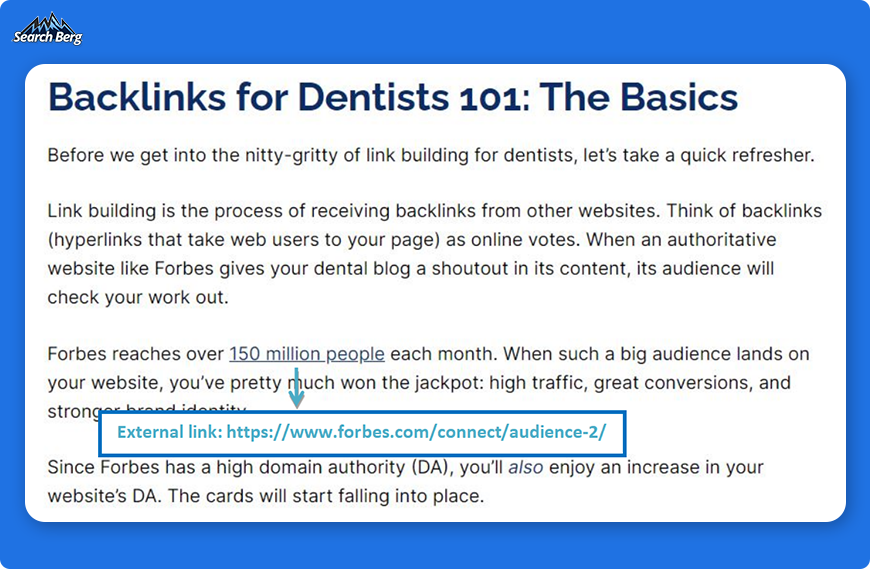
Hyperlinks leading to and from other high-authority domains act as an endorsement for both sides. They basically say, “This guy knows what he’s talking about!” and make Google view the webpage as credible.
However, links should not be inserted randomly. Every link used on a webpage should either inform or guide the reader. The purpose behind using a certain link, whether internally or externally, is called link intent.
Link intent goes beyond the superficial act of exchanging URLs between two webpages or websites. Instead, it aims to provide meaning and context to a link, making it relevant for web users and search engines alike. Understanding link intent allows users and search engines to evaluate the credibility, quality, and relevance of a certain link. High-quality relevant links help a webpage rank higher on search engines, ultimately improving the website’s Google ranking.
Different Types of Link Intent
The purpose behind adding a certain link, whether it links to another page on the same domain or a different one, significantly impacts the link’s effectiveness. When you hire a professional link-building service, this is the main thing they help you accomplish. They help build backlinks that align with the user’s intention when browsing your site’s webpages.
Let’s learn about the different types of link intent.
Informational Link Intent
Webpages mostly use links for informational purposes. The underlying intention of the link is to provide background information, additional context, or in-depth details on a specific topic. As such, informational links commonly direct to high-authority webpages and sources.
For instance, have a look at this Healthline article about properly brushing your teeth.
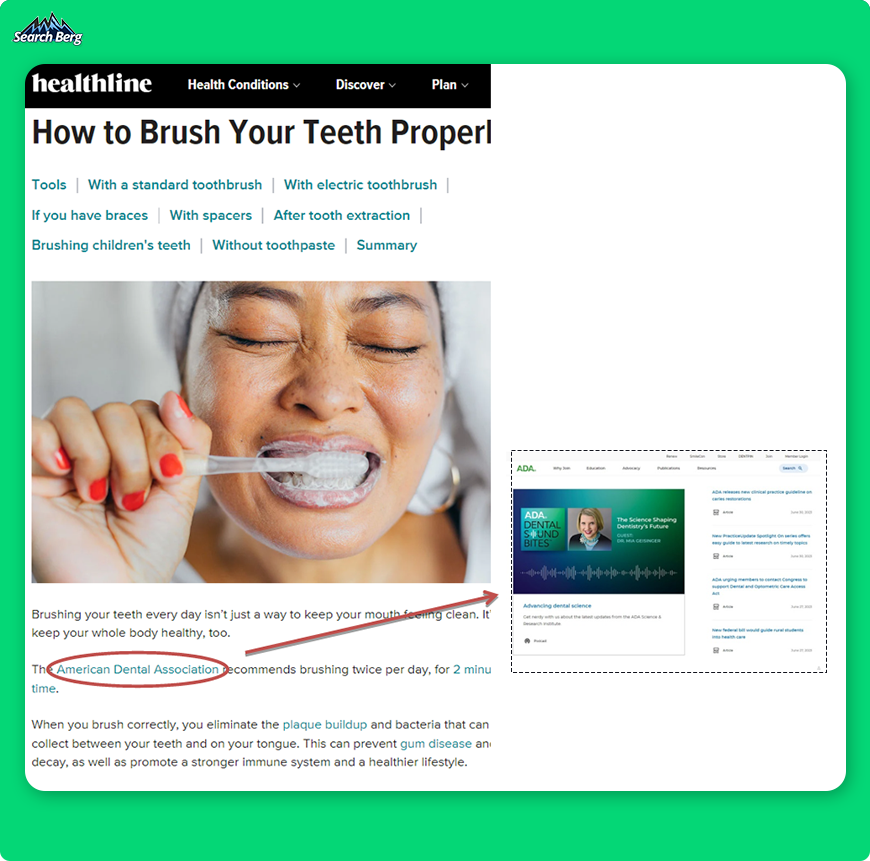
Notice how it mentions a reputable organization, cites its recommendations, and then links to its official website? This qualifies as a valuable link because it offers relevant resources to enhance the reader’s understanding. Plus, the destination website has high domain authority.
Navigational links aim to simplify user navigation by helping visitors find specific webpages within the same website or a partner site with just a click.
When directing to other pages on the same website, the overall bounce rate is reduced, and the user is more likely to stay on the website.
A screenshot from the official Apple website displays what we call Quick Links in the footer of the website.
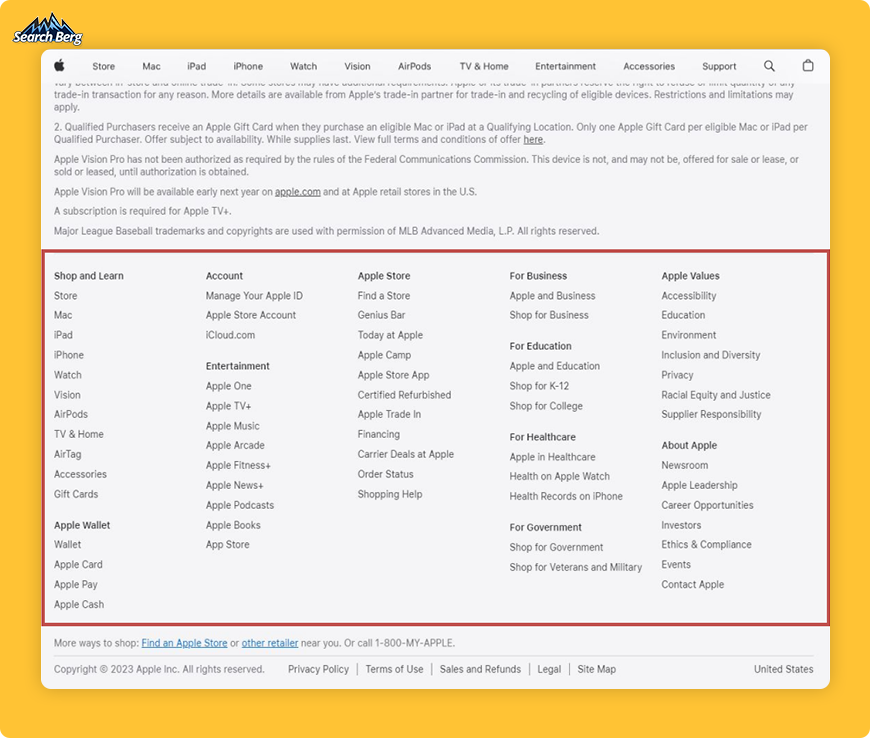
Other examples of navigational links may appear on FAQs, signup, contact, product category, and blog webpages. Take this recent Search Berg blog, for instance. Notice how the content mentions two relevant services the user might be looking for? Adding navigational links here provides the user quick access to the respective service pages.
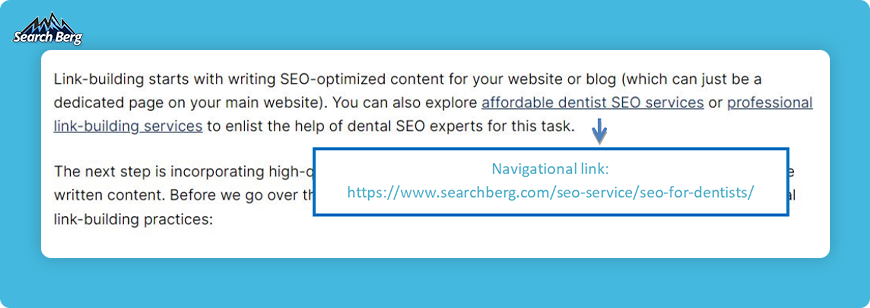
Transactional Link Intent
Transactional links aim to persuade users to take specific actions, such as making a purchase, filling out an online form, or subscribing to a newsletter.
These links are closely tied to conversions and sales-related user behaviors. The screenshot below shows three call-to-action buttons with transactional links on a Search Berg webpage for backlink building services.
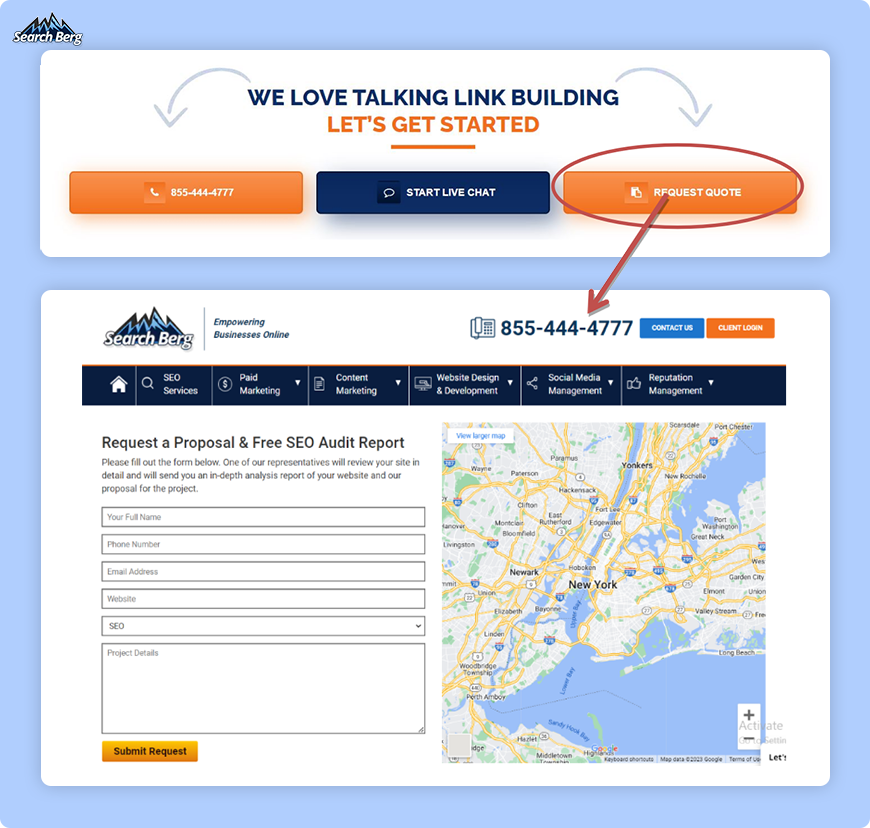
Here, linked page on the “Request Quote” button is a signup form to submit an audit request.
Similarly, this excerpt from a BigCommerce blog features a transactional link enticing users to register for the company’s affiliate program.
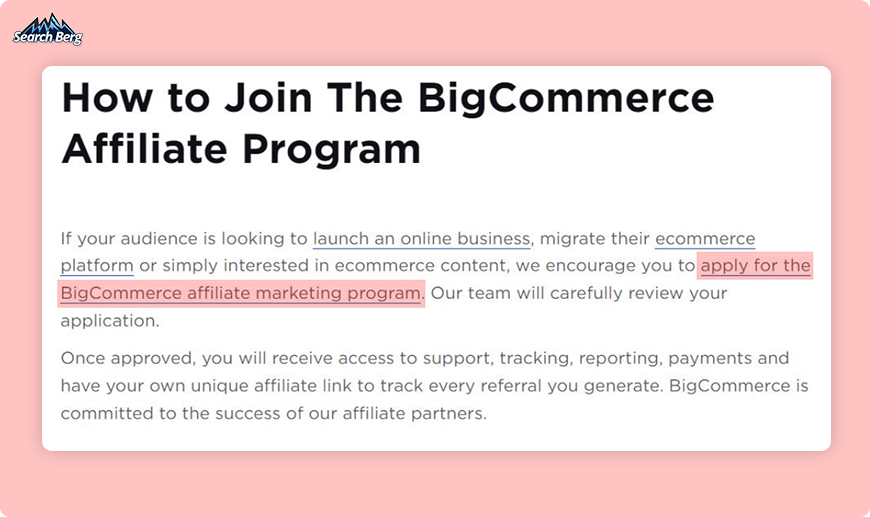
Bridging the Online Gap – The Art of Optimizing for Link Intent
Adding internal and external links is typically not enough to drive organic traffic to webpages. Each link needs to be contextually relevant to contribute positively toward the website’s search engine rankings. Links lose their value by breaking or becoming irrelevant over time, so using links strategically is critical for SEO.
Optimizing for link intent involves the process of ensuring that the content and context of each link aligns with its intent. The goal is to establish a clear and meaningful purpose for each link, allowing users and search engines to access informative, navigational, and transactional resources easily.
Whether you hire a link-building service or tackle the task yourself, the following factors will significantly impact your link intent optimization.
Relevance
Link intent is only meaningful and effective when the links being used are relevant in content and context. This basically means that the linked web page and the content in which the link appears should be aligned in terms of the subject matter.
For instance, the “Top 3 Link Building Mistakes To Avoid in 2023” blog by Search Berg mentions certain statistics.
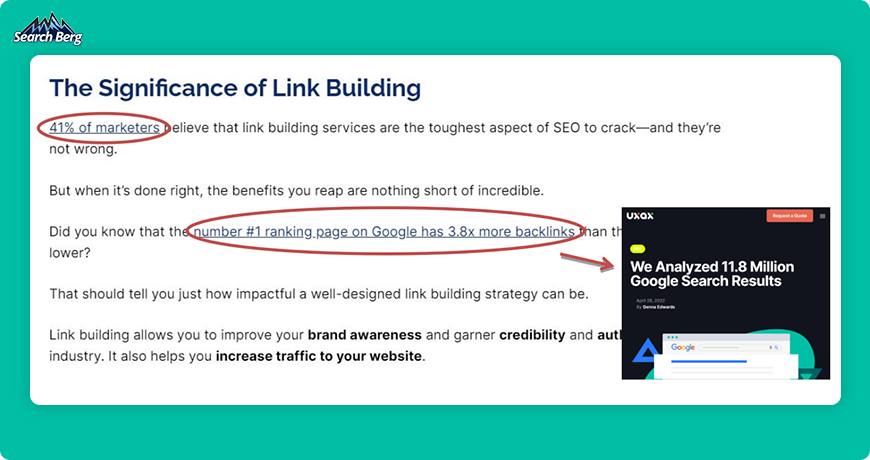
Clicking on the statistic links, the user is directed to the source of the study, thereby supporting the claims with trustworthy references. Not only does this enhance the overall credibility of the content, but it also creates a natural backlink profile.
High Domain Authority (DA)
Linking to authoritative and reputable sources plays a huge role in determining a site’s credibility. In the context of SEO, authority or Domain Authority(DA) predicts how well a website or domain is likely to rank on search engine results pages (SERPs). High DA sites, like Forbes, Adobe, and NY Times, are considered the most credible by search engines. So, earning authoritative backlinks helps your webpages rank higher by association.
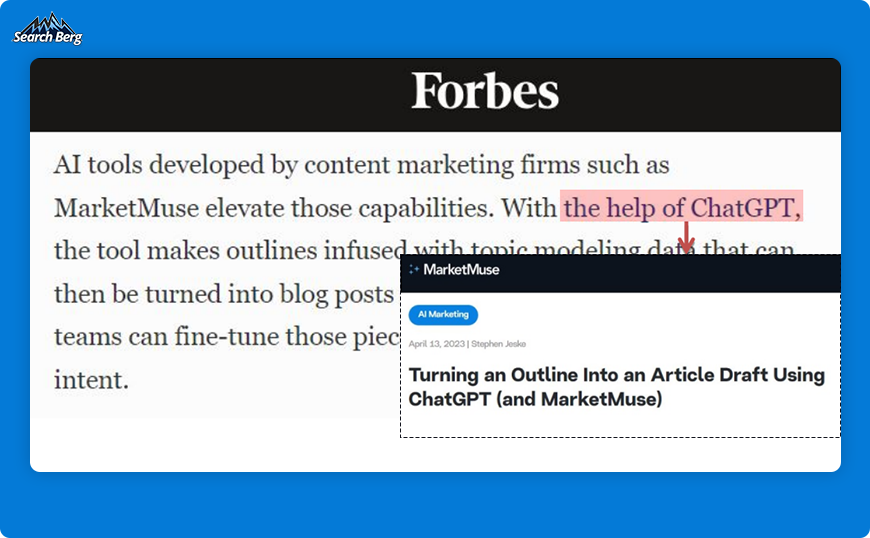
Forbes linking to a MarketMuse blog will generate organic traffic for the agency. Since Forbes has high DA, the backlink will also boost MarketMuse’s rankings on search engines, earning it a vote of credibility. So, quality backlinks with the right intent benefit both sides!
User Experience
The main goal of optimizing link intent is improving the user experience on your website. Poor linking practices can not only hurt your search engine rankings but also turn potential customers away.
Surveys show that 60% of online shoppers abandon their carts if a website or online store’s user experience is poor. Bad backlinks, i.e.,bought, spammy, irrelevant, or outdated ones, significantly hurt user experience and SEO. Good backlinks are always organic, coming from credible and relevant sources.
For instance, if a low-authority webpage for a restaurant in China backlinks to your dentistry website targeting the US, that backlink will be considered poor quality. Why? Because:
- The source is unrelated to your niche
- The source has low domain authority
- The backlink is irrelevant in context
- The backlink may count as spam
Contrarily, if a Healthline article about cosmetic dentistry hyperlinks to your dental website, that backlink will be beneficial. It will be relevant in context and will be coming from a high domain authority website, making your webpage look more credible.
Embedding high-quality links in the right places can help avoid this problem. They can lead users to important webpages and sources easily and quickly, improving the overall user experience. This leads to increased online traffic and engagement on your website.
Anchor Text
An anchor text is the clickable text that is hyperlinked and directs the user to another web page within the same domain or another.
Anchor text serves as a descriptive label for the linked content, giving users and search engines an idea of what they can expect to find on the destination page.
The anchor text should accurately reflect the link intent.Good anchor text is purposeful and relevant and includes keywords organically. On the other hand, take this screenshot of bad anchor text, for instance:

Without context, the anchor text “check out this post” might confuse readers. It’s unclear which post the text is referring to and doesn’t clarify what the users can expect when they click on this link.
Instead, using descriptive anchor text like “how to drive internet users” informs users about the content of the linked page. Remember, good anchor texts are descriptive, keyword-optimized, and contextually relevant.
Understanding the Connection Between Link Intent and Search Engine Rankings
High-quality links used strategically with the right intent can positively impact a website’s search rankings.
A well-placed link allows the search engines to use relevance as a signal to understand the context and topic of the linked page. It also helps build a network of relevant and authoritative backlinks that can contribute to higher rankings for the website.
When combined with other elements of your overall SEO strategy, like keyword research,high-quality content creation, and on-page optimization, link intent can help create a diverse and relevant backlink profile for your site. if this seems too overwhelming, you can always consult with professional link-building experts for assistance.
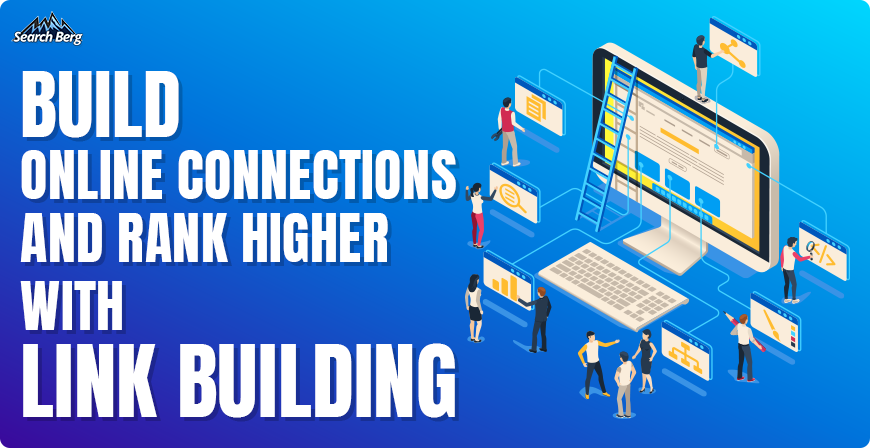
Connect with Link Building Professionals to Put Your Website on the Map!
Having a comprehensive SEO strategy is essential to achieving a spot in a search engine’s first search result page. You can hire link-building services from the experts at Search Berg to start optimizing your website today.
Our team is skilled at identifying the challenges your business website is facing and curating strategies to combat them. Whether you need our link-building services or overall SEO services, all you have to do is get in touch with our team. Give us a call or schedule an online consultation today.
Let’s put your website where the world can see it!














